Report on HR Consultant Role at Whirlpool: Development and Performance
VerifiedAdded on 2020/10/23
|14
|4086
|199
Report
AI Summary
This report, prepared for an HR consultant role at Whirlpool, analyzes the required knowledge, skills, and behaviors for the position, particularly in light of restructuring in the North American region. It includes a personal skills audit plan, identifying strengths and weaknesses in areas like communication, decision-making, and information technology skills. The report differentiates between individual and organizational learning, emphasizing their roles in employee and company development. Additionally, it explores the importance of continuous learning, professional development, high-performance working, and various performance management approaches to drive sustainable business performance and enhance employee engagement. The report offers a detailed personal development plan, focusing on improving information technology skills and decision-making abilities through targeted training and mentorship to improve performance and the overall effectiveness of the HR consultant's role.

Developing
Individuals, Teams and
Organisation
Individuals, Teams and
Organisation
Paraphrase This Document
Need a fresh take? Get an instant paraphrase of this document with our AI Paraphraser
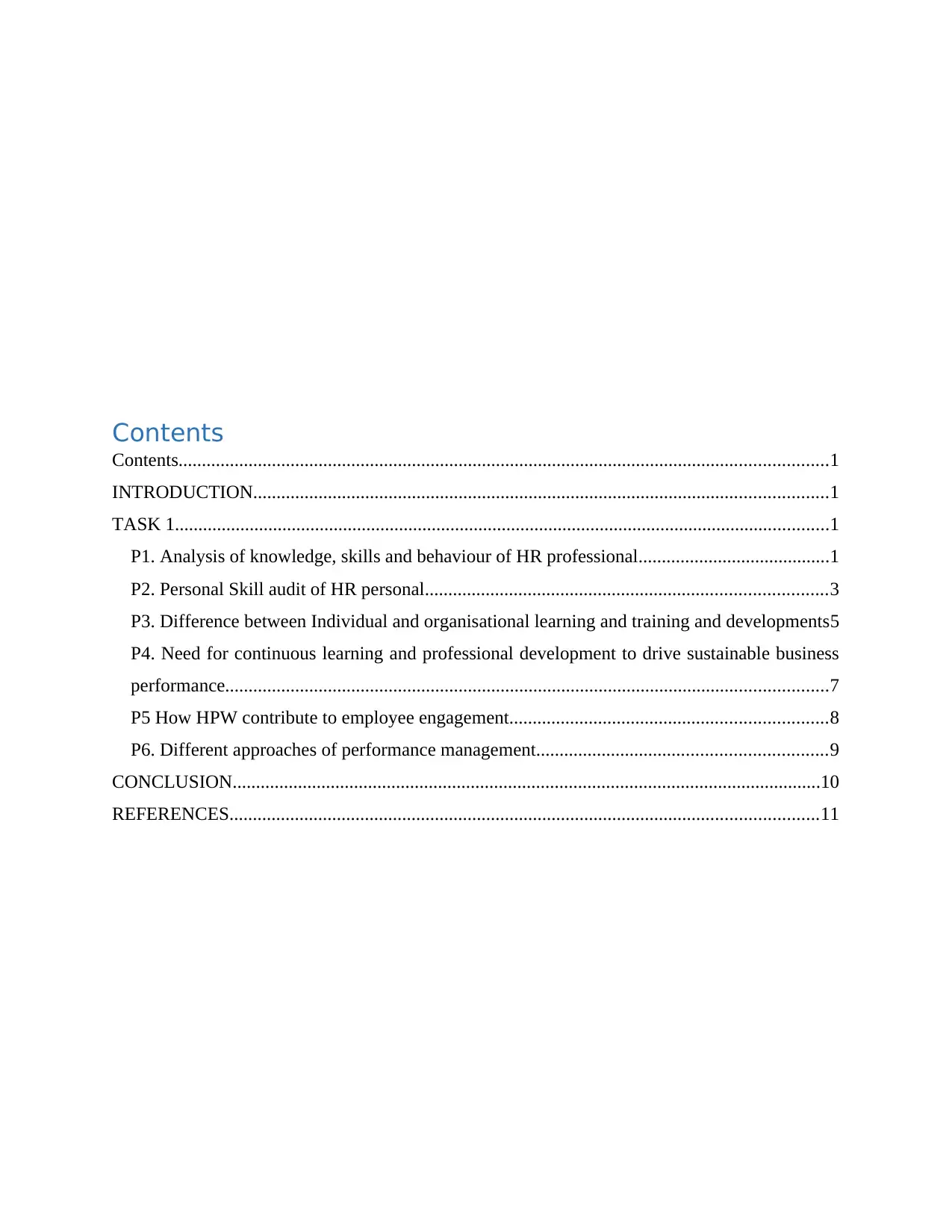
Contents
Contents...........................................................................................................................................1
INTRODUCTION...........................................................................................................................1
TASK 1............................................................................................................................................1
P1. Analysis of knowledge, skills and behaviour of HR professional.........................................1
P2. Personal Skill audit of HR personal......................................................................................3
P3. Difference between Individual and organisational learning and training and developments5
P4. Need for continuous learning and professional development to drive sustainable business
performance.................................................................................................................................7
P5 How HPW contribute to employee engagement....................................................................8
P6. Different approaches of performance management..............................................................9
CONCLUSION..............................................................................................................................10
REFERENCES..............................................................................................................................11
Contents...........................................................................................................................................1
INTRODUCTION...........................................................................................................................1
TASK 1............................................................................................................................................1
P1. Analysis of knowledge, skills and behaviour of HR professional.........................................1
P2. Personal Skill audit of HR personal......................................................................................3
P3. Difference between Individual and organisational learning and training and developments5
P4. Need for continuous learning and professional development to drive sustainable business
performance.................................................................................................................................7
P5 How HPW contribute to employee engagement....................................................................8
P6. Different approaches of performance management..............................................................9
CONCLUSION..............................................................................................................................10
REFERENCES..............................................................................................................................11

⊘ This is a preview!⊘
Do you want full access?
Subscribe today to unlock all pages.

Trusted by 1+ million students worldwide
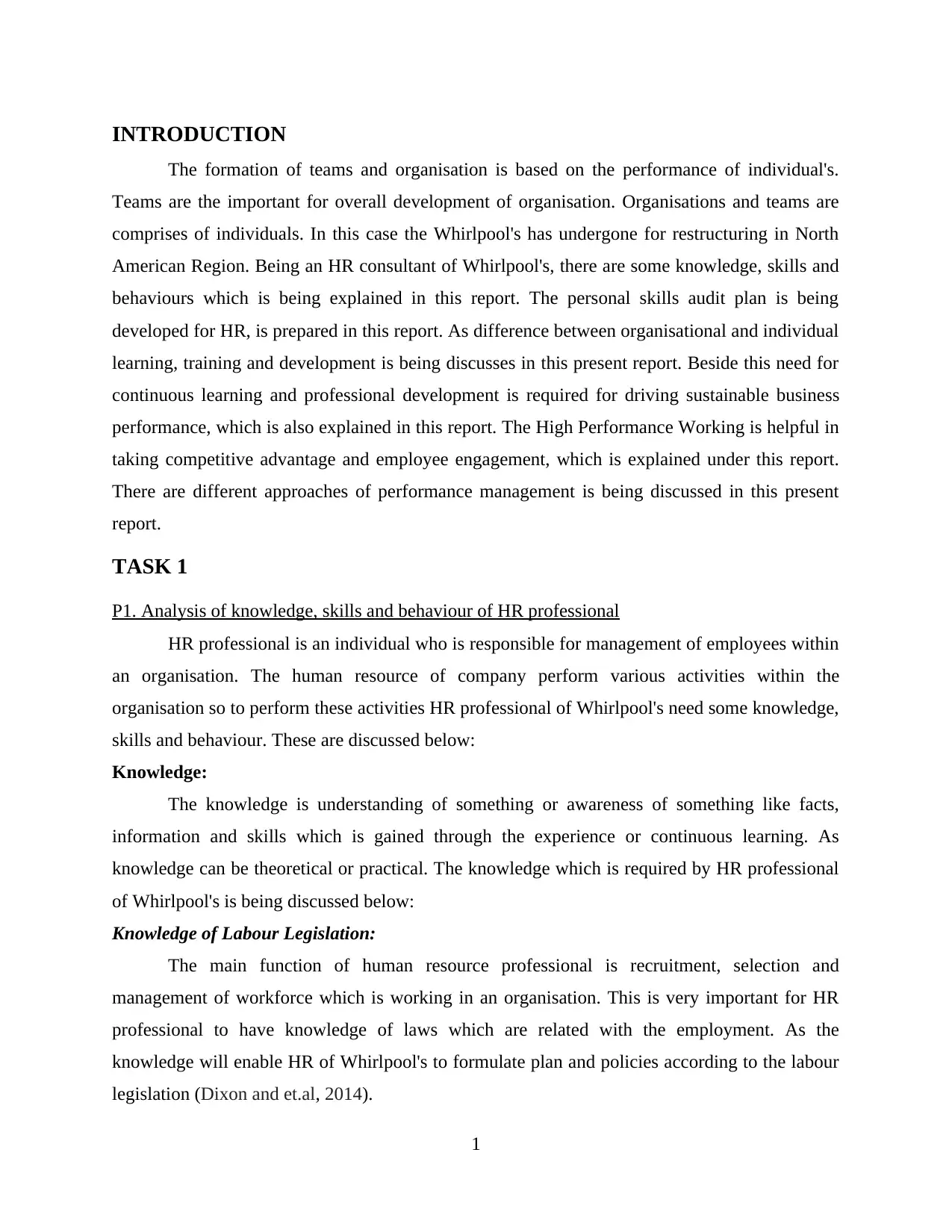
INTRODUCTION
The formation of teams and organisation is based on the performance of individual's.
Teams are the important for overall development of organisation. Organisations and teams are
comprises of individuals. In this case the Whirlpool's has undergone for restructuring in North
American Region. Being an HR consultant of Whirlpool's, there are some knowledge, skills and
behaviours which is being explained in this report. The personal skills audit plan is being
developed for HR, is prepared in this report. As difference between organisational and individual
learning, training and development is being discusses in this present report. Beside this need for
continuous learning and professional development is required for driving sustainable business
performance, which is also explained in this report. The High Performance Working is helpful in
taking competitive advantage and employee engagement, which is explained under this report.
There are different approaches of performance management is being discussed in this present
report.
TASK 1
P1. Analysis of knowledge, skills and behaviour of HR professional
HR professional is an individual who is responsible for management of employees within
an organisation. The human resource of company perform various activities within the
organisation so to perform these activities HR professional of Whirlpool's need some knowledge,
skills and behaviour. These are discussed below:
Knowledge:
The knowledge is understanding of something or awareness of something like facts,
information and skills which is gained through the experience or continuous learning. As
knowledge can be theoretical or practical. The knowledge which is required by HR professional
of Whirlpool's is being discussed below:
Knowledge of Labour Legislation:
The main function of human resource professional is recruitment, selection and
management of workforce which is working in an organisation. This is very important for HR
professional to have knowledge of laws which are related with the employment. As the
knowledge will enable HR of Whirlpool's to formulate plan and policies according to the labour
legislation (Dixon and et.al, 2014).
1
The formation of teams and organisation is based on the performance of individual's.
Teams are the important for overall development of organisation. Organisations and teams are
comprises of individuals. In this case the Whirlpool's has undergone for restructuring in North
American Region. Being an HR consultant of Whirlpool's, there are some knowledge, skills and
behaviours which is being explained in this report. The personal skills audit plan is being
developed for HR, is prepared in this report. As difference between organisational and individual
learning, training and development is being discusses in this present report. Beside this need for
continuous learning and professional development is required for driving sustainable business
performance, which is also explained in this report. The High Performance Working is helpful in
taking competitive advantage and employee engagement, which is explained under this report.
There are different approaches of performance management is being discussed in this present
report.
TASK 1
P1. Analysis of knowledge, skills and behaviour of HR professional
HR professional is an individual who is responsible for management of employees within
an organisation. The human resource of company perform various activities within the
organisation so to perform these activities HR professional of Whirlpool's need some knowledge,
skills and behaviour. These are discussed below:
Knowledge:
The knowledge is understanding of something or awareness of something like facts,
information and skills which is gained through the experience or continuous learning. As
knowledge can be theoretical or practical. The knowledge which is required by HR professional
of Whirlpool's is being discussed below:
Knowledge of Labour Legislation:
The main function of human resource professional is recruitment, selection and
management of workforce which is working in an organisation. This is very important for HR
professional to have knowledge of laws which are related with the employment. As the
knowledge will enable HR of Whirlpool's to formulate plan and policies according to the labour
legislation (Dixon and et.al, 2014).
1
Paraphrase This Document
Need a fresh take? Get an instant paraphrase of this document with our AI Paraphraser
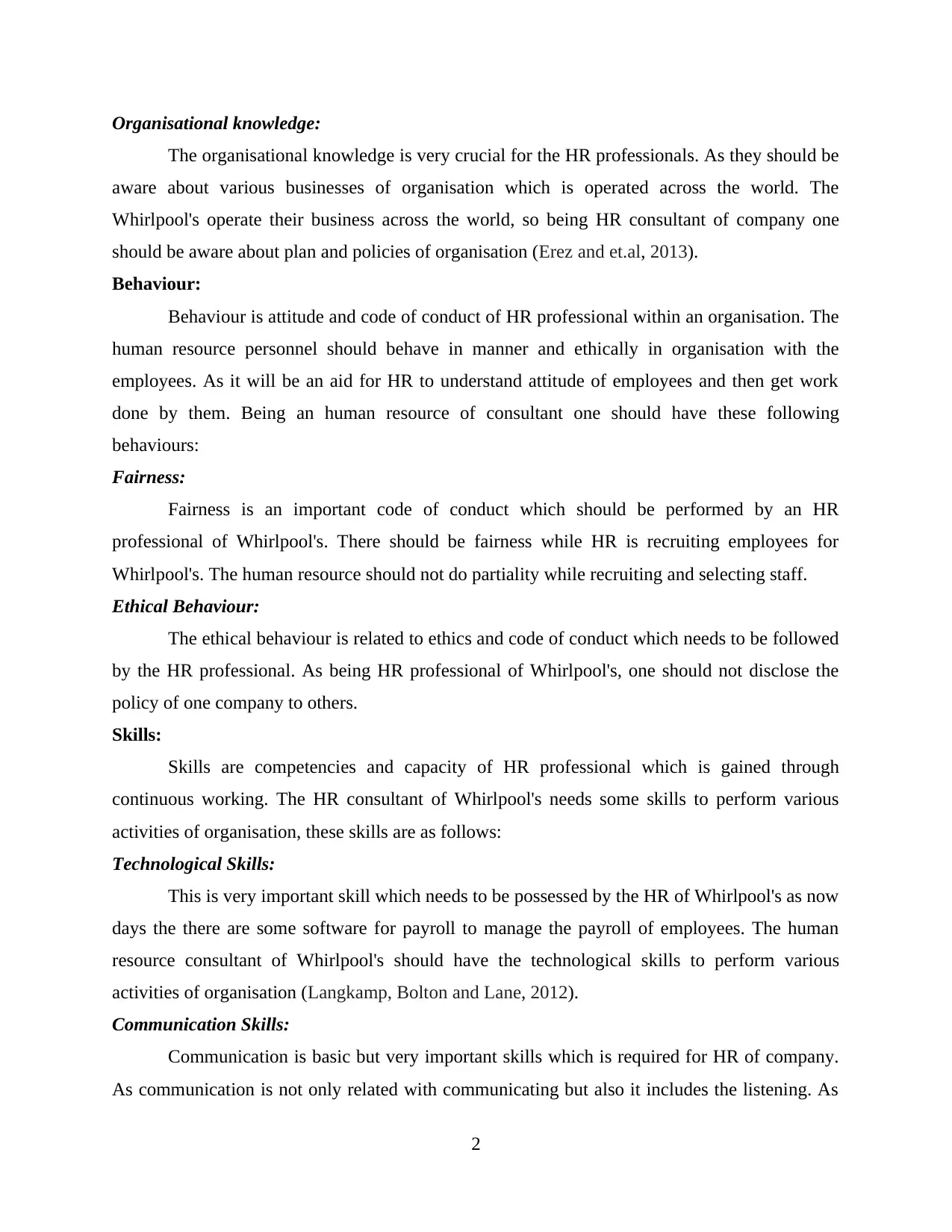
Organisational knowledge:
The organisational knowledge is very crucial for the HR professionals. As they should be
aware about various businesses of organisation which is operated across the world. The
Whirlpool's operate their business across the world, so being HR consultant of company one
should be aware about plan and policies of organisation (Erez and et.al, 2013).
Behaviour:
Behaviour is attitude and code of conduct of HR professional within an organisation. The
human resource personnel should behave in manner and ethically in organisation with the
employees. As it will be an aid for HR to understand attitude of employees and then get work
done by them. Being an human resource of consultant one should have these following
behaviours:
Fairness:
Fairness is an important code of conduct which should be performed by an HR
professional of Whirlpool's. There should be fairness while HR is recruiting employees for
Whirlpool's. The human resource should not do partiality while recruiting and selecting staff.
Ethical Behaviour:
The ethical behaviour is related to ethics and code of conduct which needs to be followed
by the HR professional. As being HR professional of Whirlpool's, one should not disclose the
policy of one company to others.
Skills:
Skills are competencies and capacity of HR professional which is gained through
continuous working. The HR consultant of Whirlpool's needs some skills to perform various
activities of organisation, these skills are as follows:
Technological Skills:
This is very important skill which needs to be possessed by the HR of Whirlpool's as now
days the there are some software for payroll to manage the payroll of employees. The human
resource consultant of Whirlpool's should have the technological skills to perform various
activities of organisation (Langkamp, Bolton and Lane, 2012).
Communication Skills:
Communication is basic but very important skills which is required for HR of company.
As communication is not only related with communicating but also it includes the listening. As
2
The organisational knowledge is very crucial for the HR professionals. As they should be
aware about various businesses of organisation which is operated across the world. The
Whirlpool's operate their business across the world, so being HR consultant of company one
should be aware about plan and policies of organisation (Erez and et.al, 2013).
Behaviour:
Behaviour is attitude and code of conduct of HR professional within an organisation. The
human resource personnel should behave in manner and ethically in organisation with the
employees. As it will be an aid for HR to understand attitude of employees and then get work
done by them. Being an human resource of consultant one should have these following
behaviours:
Fairness:
Fairness is an important code of conduct which should be performed by an HR
professional of Whirlpool's. There should be fairness while HR is recruiting employees for
Whirlpool's. The human resource should not do partiality while recruiting and selecting staff.
Ethical Behaviour:
The ethical behaviour is related to ethics and code of conduct which needs to be followed
by the HR professional. As being HR professional of Whirlpool's, one should not disclose the
policy of one company to others.
Skills:
Skills are competencies and capacity of HR professional which is gained through
continuous working. The HR consultant of Whirlpool's needs some skills to perform various
activities of organisation, these skills are as follows:
Technological Skills:
This is very important skill which needs to be possessed by the HR of Whirlpool's as now
days the there are some software for payroll to manage the payroll of employees. The human
resource consultant of Whirlpool's should have the technological skills to perform various
activities of organisation (Langkamp, Bolton and Lane, 2012).
Communication Skills:
Communication is basic but very important skills which is required for HR of company.
As communication is not only related with communicating but also it includes the listening. As
2
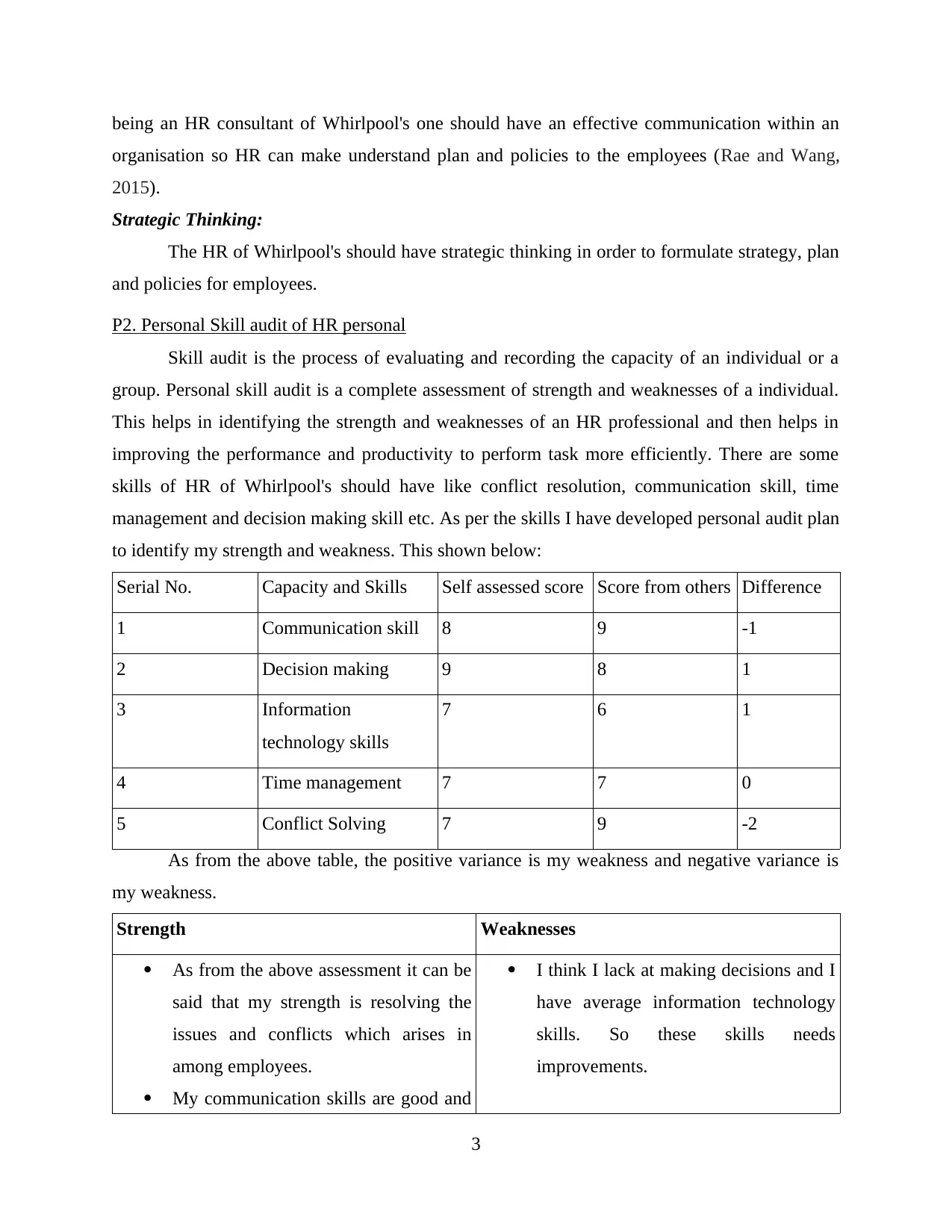
being an HR consultant of Whirlpool's one should have an effective communication within an
organisation so HR can make understand plan and policies to the employees (Rae and Wang,
2015).
Strategic Thinking:
The HR of Whirlpool's should have strategic thinking in order to formulate strategy, plan
and policies for employees.
P2. Personal Skill audit of HR personal
Skill audit is the process of evaluating and recording the capacity of an individual or a
group. Personal skill audit is a complete assessment of strength and weaknesses of a individual.
This helps in identifying the strength and weaknesses of an HR professional and then helps in
improving the performance and productivity to perform task more efficiently. There are some
skills of HR of Whirlpool's should have like conflict resolution, communication skill, time
management and decision making skill etc. As per the skills I have developed personal audit plan
to identify my strength and weakness. This shown below:
Serial No. Capacity and Skills Self assessed score Score from others Difference
1 Communication skill 8 9 -1
2 Decision making 9 8 1
3 Information
technology skills
7 6 1
4 Time management 7 7 0
5 Conflict Solving 7 9 -2
As from the above table, the positive variance is my weakness and negative variance is
my weakness.
Strength Weaknesses
As from the above assessment it can be
said that my strength is resolving the
issues and conflicts which arises in
among employees.
My communication skills are good and
I think I lack at making decisions and I
have average information technology
skills. So these skills needs
improvements.
3
organisation so HR can make understand plan and policies to the employees (Rae and Wang,
2015).
Strategic Thinking:
The HR of Whirlpool's should have strategic thinking in order to formulate strategy, plan
and policies for employees.
P2. Personal Skill audit of HR personal
Skill audit is the process of evaluating and recording the capacity of an individual or a
group. Personal skill audit is a complete assessment of strength and weaknesses of a individual.
This helps in identifying the strength and weaknesses of an HR professional and then helps in
improving the performance and productivity to perform task more efficiently. There are some
skills of HR of Whirlpool's should have like conflict resolution, communication skill, time
management and decision making skill etc. As per the skills I have developed personal audit plan
to identify my strength and weakness. This shown below:
Serial No. Capacity and Skills Self assessed score Score from others Difference
1 Communication skill 8 9 -1
2 Decision making 9 8 1
3 Information
technology skills
7 6 1
4 Time management 7 7 0
5 Conflict Solving 7 9 -2
As from the above table, the positive variance is my weakness and negative variance is
my weakness.
Strength Weaknesses
As from the above assessment it can be
said that my strength is resolving the
issues and conflicts which arises in
among employees.
My communication skills are good and
I think I lack at making decisions and I
have average information technology
skills. So these skills needs
improvements.
3
⊘ This is a preview!⊘
Do you want full access?
Subscribe today to unlock all pages.

Trusted by 1+ million students worldwide
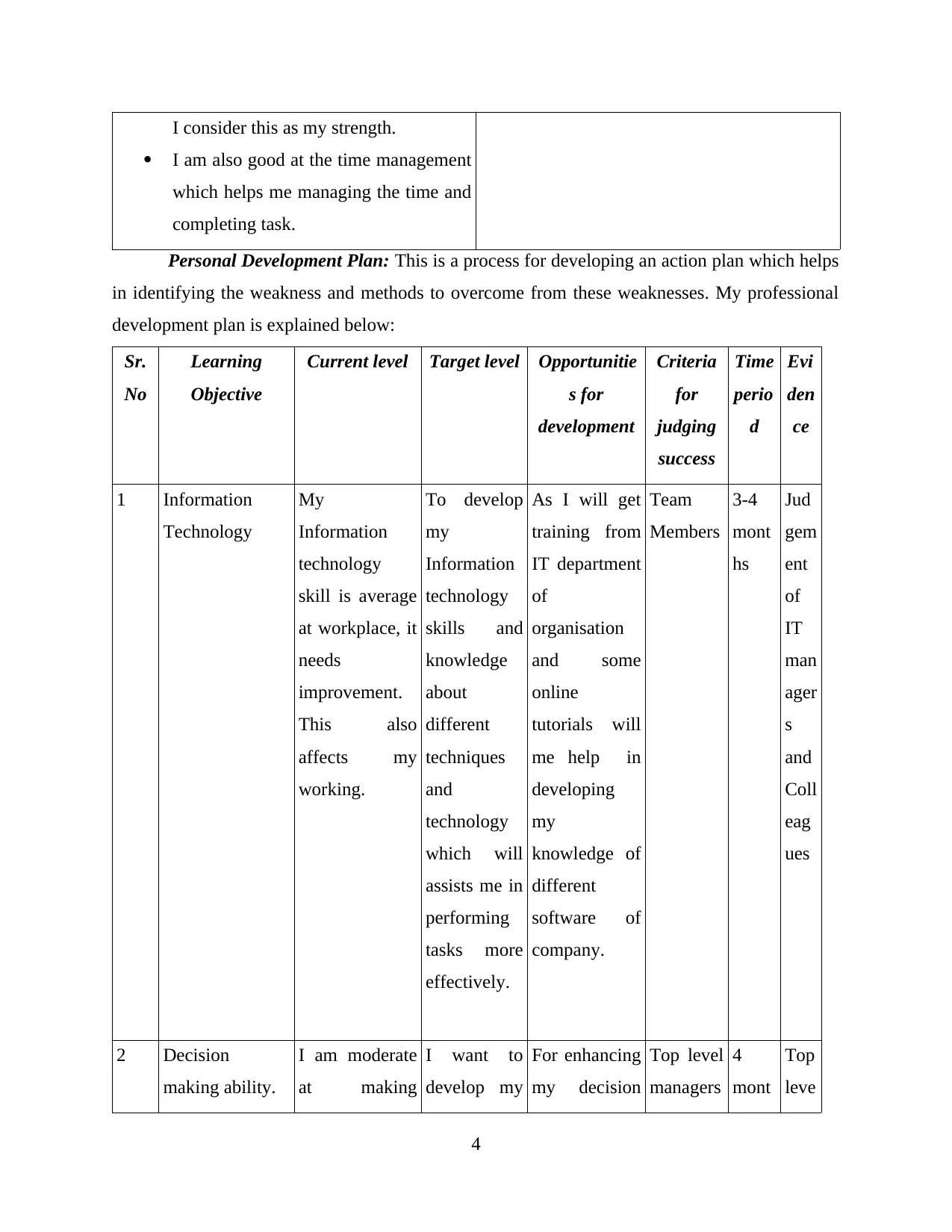
I consider this as my strength.
I am also good at the time management
which helps me managing the time and
completing task.
Personal Development Plan: This is a process for developing an action plan which helps
in identifying the weakness and methods to overcome from these weaknesses. My professional
development plan is explained below:
Sr.
No
Learning
Objective
Current level Target level Opportunitie
s for
development
Criteria
for
judging
success
Time
perio
d
Evi
den
ce
1 Information
Technology
My
Information
technology
skill is average
at workplace, it
needs
improvement.
This also
affects my
working.
To develop
my
Information
technology
skills and
knowledge
about
different
techniques
and
technology
which will
assists me in
performing
tasks more
effectively.
As I will get
training from
IT department
of
organisation
and some
online
tutorials will
me help in
developing
my
knowledge of
different
software of
company.
Team
Members
3-4
mont
hs
Jud
gem
ent
of
IT
man
ager
s
and
Coll
eag
ues
2 Decision
making ability.
I am moderate
at making
I want to
develop my
For enhancing
my decision
Top level
managers
4
mont
Top
leve
4
I am also good at the time management
which helps me managing the time and
completing task.
Personal Development Plan: This is a process for developing an action plan which helps
in identifying the weakness and methods to overcome from these weaknesses. My professional
development plan is explained below:
Sr.
No
Learning
Objective
Current level Target level Opportunitie
s for
development
Criteria
for
judging
success
Time
perio
d
Evi
den
ce
1 Information
Technology
My
Information
technology
skill is average
at workplace, it
needs
improvement.
This also
affects my
working.
To develop
my
Information
technology
skills and
knowledge
about
different
techniques
and
technology
which will
assists me in
performing
tasks more
effectively.
As I will get
training from
IT department
of
organisation
and some
online
tutorials will
me help in
developing
my
knowledge of
different
software of
company.
Team
Members
3-4
mont
hs
Jud
gem
ent
of
IT
man
ager
s
and
Coll
eag
ues
2 Decision
making ability.
I am moderate
at making
I want to
develop my
For enhancing
my decision
Top level
managers
4
mont
Top
leve
4
Paraphrase This Document
Need a fresh take? Get an instant paraphrase of this document with our AI Paraphraser
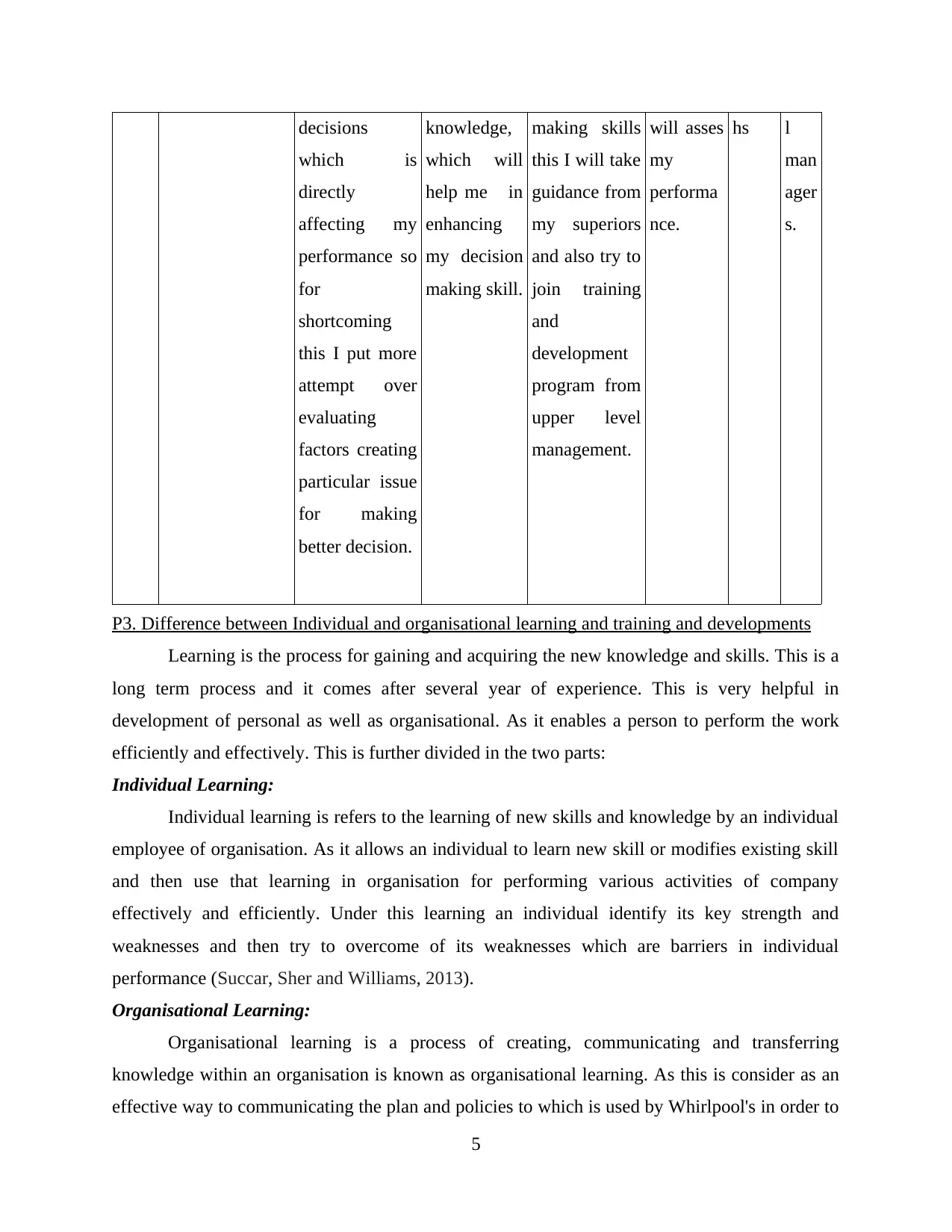
decisions
which is
directly
affecting my
performance so
for
shortcoming
this I put more
attempt over
evaluating
factors creating
particular issue
for making
better decision.
knowledge,
which will
help me in
enhancing
my decision
making skill.
making skills
this I will take
guidance from
my superiors
and also try to
join training
and
development
program from
upper level
management.
will asses
my
performa
nce.
hs l
man
ager
s.
P3. Difference between Individual and organisational learning and training and developments
Learning is the process for gaining and acquiring the new knowledge and skills. This is a
long term process and it comes after several year of experience. This is very helpful in
development of personal as well as organisational. As it enables a person to perform the work
efficiently and effectively. This is further divided in the two parts:
Individual Learning:
Individual learning is refers to the learning of new skills and knowledge by an individual
employee of organisation. As it allows an individual to learn new skill or modifies existing skill
and then use that learning in organisation for performing various activities of company
effectively and efficiently. Under this learning an individual identify its key strength and
weaknesses and then try to overcome of its weaknesses which are barriers in individual
performance (Succar, Sher and Williams, 2013).
Organisational Learning:
Organisational learning is a process of creating, communicating and transferring
knowledge within an organisation is known as organisational learning. As this is consider as an
effective way to communicating the plan and policies to which is used by Whirlpool's in order to
5
which is
directly
affecting my
performance so
for
shortcoming
this I put more
attempt over
evaluating
factors creating
particular issue
for making
better decision.
knowledge,
which will
help me in
enhancing
my decision
making skill.
making skills
this I will take
guidance from
my superiors
and also try to
join training
and
development
program from
upper level
management.
will asses
my
performa
nce.
hs l
man
ager
s.
P3. Difference between Individual and organisational learning and training and developments
Learning is the process for gaining and acquiring the new knowledge and skills. This is a
long term process and it comes after several year of experience. This is very helpful in
development of personal as well as organisational. As it enables a person to perform the work
efficiently and effectively. This is further divided in the two parts:
Individual Learning:
Individual learning is refers to the learning of new skills and knowledge by an individual
employee of organisation. As it allows an individual to learn new skill or modifies existing skill
and then use that learning in organisation for performing various activities of company
effectively and efficiently. Under this learning an individual identify its key strength and
weaknesses and then try to overcome of its weaknesses which are barriers in individual
performance (Succar, Sher and Williams, 2013).
Organisational Learning:
Organisational learning is a process of creating, communicating and transferring
knowledge within an organisation is known as organisational learning. As this is consider as an
effective way to communicating the plan and policies to which is used by Whirlpool's in order to
5

achieve th organisational goals. This process is used by the HR officers of Whirlpool's for
executing the creative way and styles for learning and contributing towards the company's
success.
Difference between organisational and individual learning:
Individual Learning Organisational Learning
Individual learning is a process of
learning new skills and enhancing the
productivity of individual employee.
This is long term and career oriented process
which mainly emphasize on enhancing the
interpersonal skills of employees within
organisation so they can perform better. As
Whirlpool's can use this process in order to
enhance the skills of its employees so they can
face situation like restructuring (Tabassi,
Ramli and Bakar, 2012)
Organisational learning main objective
is enhance the knowledge and skills of
a group as whole. It can be helpful for
the Whirlpool's to enhance performance
of overall organisation and achieve its
goals.
This process is helpful in development
of skills organisation as whole. It
mainly focus on the convert the efforts
of employees into organisational
success.
Training and Development:
Training and development is a core function of organisation which is performed by the
human resource management. Training is a process which focus on the learning of skills to new
employees of organisation so they can perform better in their tasks. As training is a part of
induction because basically it is given to new employees of company. Development is focus on
overall development of existing employees. It is a continuous process and it for existing
employees of organisation. The HR of Whirlpool's can give training and development to their
employees so that they can perform better and can handle the situations.
Difference between Training and Development
Basis Training Development
Meaning Training is a learning process
which employees gets an
opportunity to learn skill and
Development is concerned
with the overall growth of
employees.
6
executing the creative way and styles for learning and contributing towards the company's
success.
Difference between organisational and individual learning:
Individual Learning Organisational Learning
Individual learning is a process of
learning new skills and enhancing the
productivity of individual employee.
This is long term and career oriented process
which mainly emphasize on enhancing the
interpersonal skills of employees within
organisation so they can perform better. As
Whirlpool's can use this process in order to
enhance the skills of its employees so they can
face situation like restructuring (Tabassi,
Ramli and Bakar, 2012)
Organisational learning main objective
is enhance the knowledge and skills of
a group as whole. It can be helpful for
the Whirlpool's to enhance performance
of overall organisation and achieve its
goals.
This process is helpful in development
of skills organisation as whole. It
mainly focus on the convert the efforts
of employees into organisational
success.
Training and Development:
Training and development is a core function of organisation which is performed by the
human resource management. Training is a process which focus on the learning of skills to new
employees of organisation so they can perform better in their tasks. As training is a part of
induction because basically it is given to new employees of company. Development is focus on
overall development of existing employees. It is a continuous process and it for existing
employees of organisation. The HR of Whirlpool's can give training and development to their
employees so that they can perform better and can handle the situations.
Difference between Training and Development
Basis Training Development
Meaning Training is a learning process
which employees gets an
opportunity to learn skill and
Development is concerned
with the overall growth of
employees.
6
⊘ This is a preview!⊘
Do you want full access?
Subscribe today to unlock all pages.

Trusted by 1+ million students worldwide
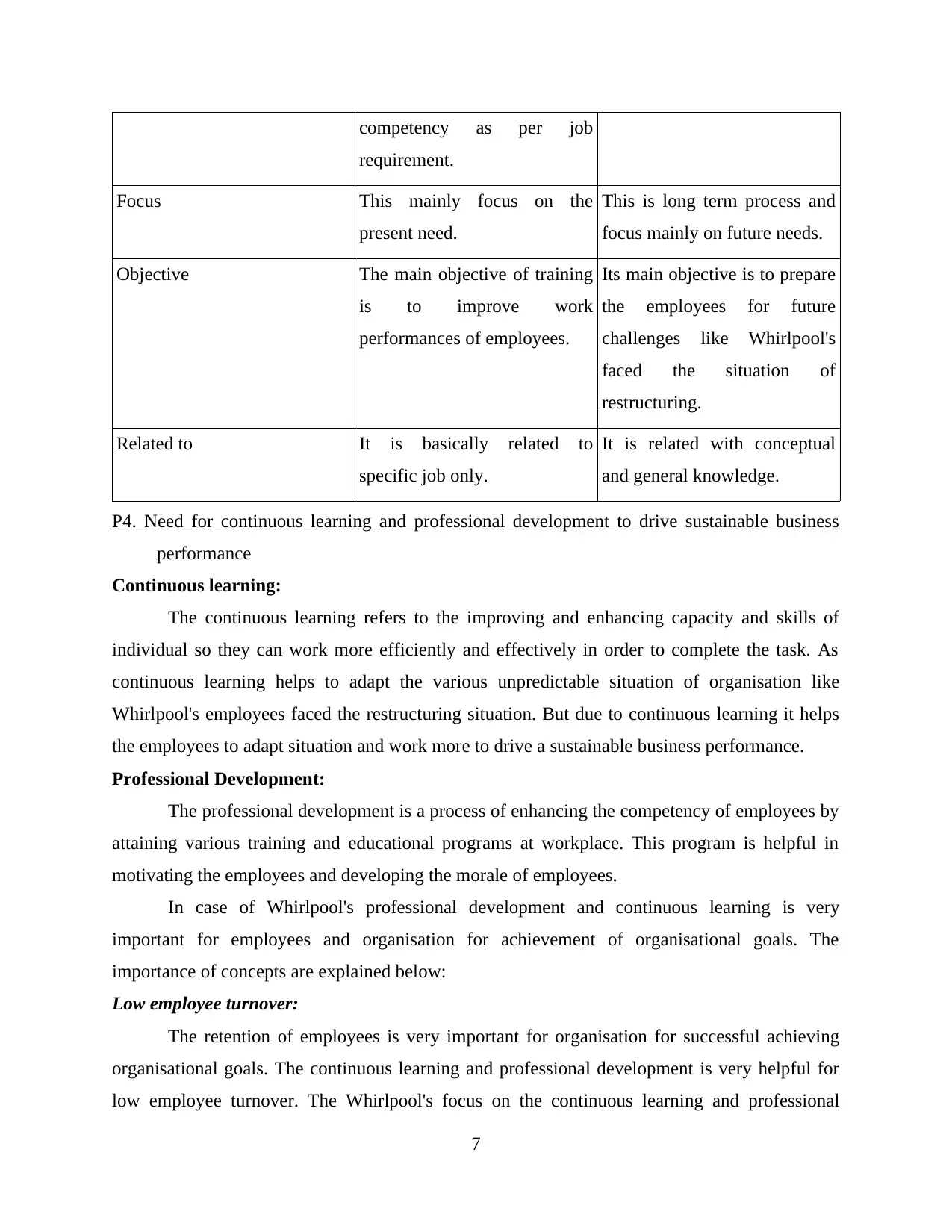
competency as per job
requirement.
Focus This mainly focus on the
present need.
This is long term process and
focus mainly on future needs.
Objective The main objective of training
is to improve work
performances of employees.
Its main objective is to prepare
the employees for future
challenges like Whirlpool's
faced the situation of
restructuring.
Related to It is basically related to
specific job only.
It is related with conceptual
and general knowledge.
P4. Need for continuous learning and professional development to drive sustainable business
performance
Continuous learning:
The continuous learning refers to the improving and enhancing capacity and skills of
individual so they can work more efficiently and effectively in order to complete the task. As
continuous learning helps to adapt the various unpredictable situation of organisation like
Whirlpool's employees faced the restructuring situation. But due to continuous learning it helps
the employees to adapt situation and work more to drive a sustainable business performance.
Professional Development:
The professional development is a process of enhancing the competency of employees by
attaining various training and educational programs at workplace. This program is helpful in
motivating the employees and developing the morale of employees.
In case of Whirlpool's professional development and continuous learning is very
important for employees and organisation for achievement of organisational goals. The
importance of concepts are explained below:
Low employee turnover:
The retention of employees is very important for organisation for successful achieving
organisational goals. The continuous learning and professional development is very helpful for
low employee turnover. The Whirlpool's focus on the continuous learning and professional
7
requirement.
Focus This mainly focus on the
present need.
This is long term process and
focus mainly on future needs.
Objective The main objective of training
is to improve work
performances of employees.
Its main objective is to prepare
the employees for future
challenges like Whirlpool's
faced the situation of
restructuring.
Related to It is basically related to
specific job only.
It is related with conceptual
and general knowledge.
P4. Need for continuous learning and professional development to drive sustainable business
performance
Continuous learning:
The continuous learning refers to the improving and enhancing capacity and skills of
individual so they can work more efficiently and effectively in order to complete the task. As
continuous learning helps to adapt the various unpredictable situation of organisation like
Whirlpool's employees faced the restructuring situation. But due to continuous learning it helps
the employees to adapt situation and work more to drive a sustainable business performance.
Professional Development:
The professional development is a process of enhancing the competency of employees by
attaining various training and educational programs at workplace. This program is helpful in
motivating the employees and developing the morale of employees.
In case of Whirlpool's professional development and continuous learning is very
important for employees and organisation for achievement of organisational goals. The
importance of concepts are explained below:
Low employee turnover:
The retention of employees is very important for organisation for successful achieving
organisational goals. The continuous learning and professional development is very helpful for
low employee turnover. The Whirlpool's focus on the continuous learning and professional
7
Paraphrase This Document
Need a fresh take? Get an instant paraphrase of this document with our AI Paraphraser
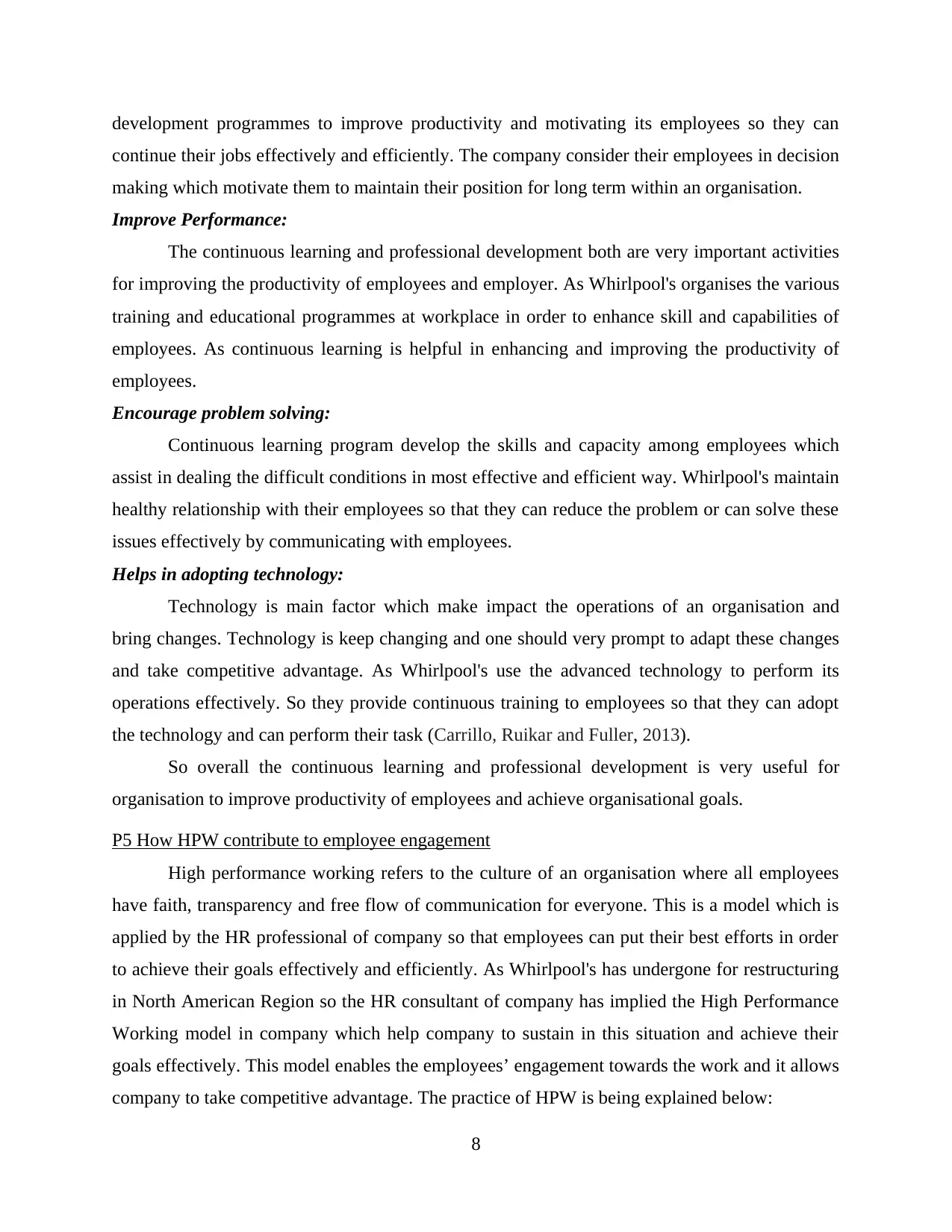
development programmes to improve productivity and motivating its employees so they can
continue their jobs effectively and efficiently. The company consider their employees in decision
making which motivate them to maintain their position for long term within an organisation.
Improve Performance:
The continuous learning and professional development both are very important activities
for improving the productivity of employees and employer. As Whirlpool's organises the various
training and educational programmes at workplace in order to enhance skill and capabilities of
employees. As continuous learning is helpful in enhancing and improving the productivity of
employees.
Encourage problem solving:
Continuous learning program develop the skills and capacity among employees which
assist in dealing the difficult conditions in most effective and efficient way. Whirlpool's maintain
healthy relationship with their employees so that they can reduce the problem or can solve these
issues effectively by communicating with employees.
Helps in adopting technology:
Technology is main factor which make impact the operations of an organisation and
bring changes. Technology is keep changing and one should very prompt to adapt these changes
and take competitive advantage. As Whirlpool's use the advanced technology to perform its
operations effectively. So they provide continuous training to employees so that they can adopt
the technology and can perform their task (Carrillo, Ruikar and Fuller, 2013).
So overall the continuous learning and professional development is very useful for
organisation to improve productivity of employees and achieve organisational goals.
P5 How HPW contribute to employee engagement
High performance working refers to the culture of an organisation where all employees
have faith, transparency and free flow of communication for everyone. This is a model which is
applied by the HR professional of company so that employees can put their best efforts in order
to achieve their goals effectively and efficiently. As Whirlpool's has undergone for restructuring
in North American Region so the HR consultant of company has implied the High Performance
Working model in company which help company to sustain in this situation and achieve their
goals effectively. This model enables the employees’ engagement towards the work and it allows
company to take competitive advantage. The practice of HPW is being explained below:
8
continue their jobs effectively and efficiently. The company consider their employees in decision
making which motivate them to maintain their position for long term within an organisation.
Improve Performance:
The continuous learning and professional development both are very important activities
for improving the productivity of employees and employer. As Whirlpool's organises the various
training and educational programmes at workplace in order to enhance skill and capabilities of
employees. As continuous learning is helpful in enhancing and improving the productivity of
employees.
Encourage problem solving:
Continuous learning program develop the skills and capacity among employees which
assist in dealing the difficult conditions in most effective and efficient way. Whirlpool's maintain
healthy relationship with their employees so that they can reduce the problem or can solve these
issues effectively by communicating with employees.
Helps in adopting technology:
Technology is main factor which make impact the operations of an organisation and
bring changes. Technology is keep changing and one should very prompt to adapt these changes
and take competitive advantage. As Whirlpool's use the advanced technology to perform its
operations effectively. So they provide continuous training to employees so that they can adopt
the technology and can perform their task (Carrillo, Ruikar and Fuller, 2013).
So overall the continuous learning and professional development is very useful for
organisation to improve productivity of employees and achieve organisational goals.
P5 How HPW contribute to employee engagement
High performance working refers to the culture of an organisation where all employees
have faith, transparency and free flow of communication for everyone. This is a model which is
applied by the HR professional of company so that employees can put their best efforts in order
to achieve their goals effectively and efficiently. As Whirlpool's has undergone for restructuring
in North American Region so the HR consultant of company has implied the High Performance
Working model in company which help company to sustain in this situation and achieve their
goals effectively. This model enables the employees’ engagement towards the work and it allows
company to take competitive advantage. The practice of HPW is being explained below:
8
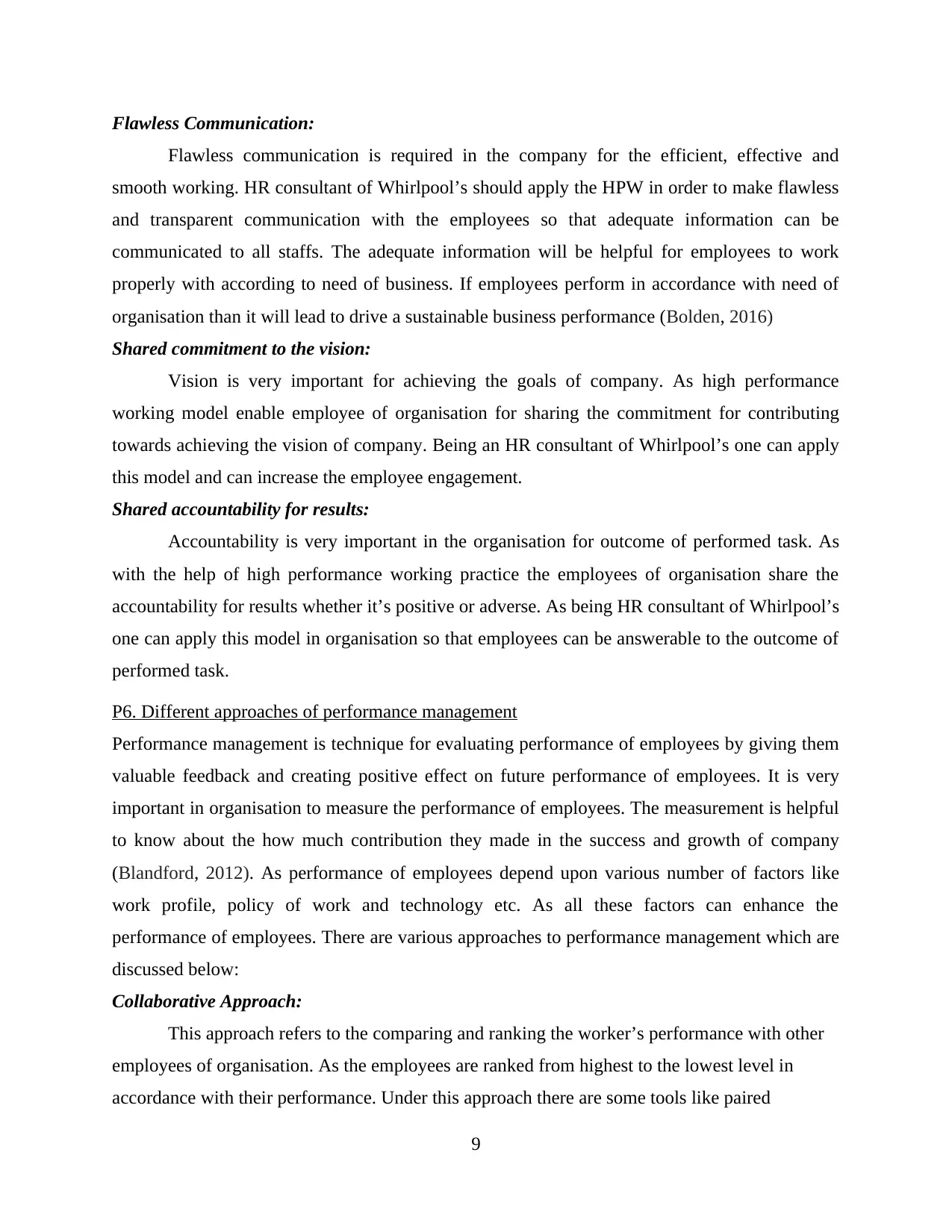
Flawless Communication:
Flawless communication is required in the company for the efficient, effective and
smooth working. HR consultant of Whirlpool’s should apply the HPW in order to make flawless
and transparent communication with the employees so that adequate information can be
communicated to all staffs. The adequate information will be helpful for employees to work
properly with according to need of business. If employees perform in accordance with need of
organisation than it will lead to drive a sustainable business performance (Bolden, 2016)
Shared commitment to the vision:
Vision is very important for achieving the goals of company. As high performance
working model enable employee of organisation for sharing the commitment for contributing
towards achieving the vision of company. Being an HR consultant of Whirlpool’s one can apply
this model and can increase the employee engagement.
Shared accountability for results:
Accountability is very important in the organisation for outcome of performed task. As
with the help of high performance working practice the employees of organisation share the
accountability for results whether it’s positive or adverse. As being HR consultant of Whirlpool’s
one can apply this model in organisation so that employees can be answerable to the outcome of
performed task.
P6. Different approaches of performance management
Performance management is technique for evaluating performance of employees by giving them
valuable feedback and creating positive effect on future performance of employees. It is very
important in organisation to measure the performance of employees. The measurement is helpful
to know about the how much contribution they made in the success and growth of company
(Blandford, 2012). As performance of employees depend upon various number of factors like
work profile, policy of work and technology etc. As all these factors can enhance the
performance of employees. There are various approaches to performance management which are
discussed below:
Collaborative Approach:
This approach refers to the comparing and ranking the worker’s performance with other
employees of organisation. As the employees are ranked from highest to the lowest level in
accordance with their performance. Under this approach there are some tools like paired
9
Flawless communication is required in the company for the efficient, effective and
smooth working. HR consultant of Whirlpool’s should apply the HPW in order to make flawless
and transparent communication with the employees so that adequate information can be
communicated to all staffs. The adequate information will be helpful for employees to work
properly with according to need of business. If employees perform in accordance with need of
organisation than it will lead to drive a sustainable business performance (Bolden, 2016)
Shared commitment to the vision:
Vision is very important for achieving the goals of company. As high performance
working model enable employee of organisation for sharing the commitment for contributing
towards achieving the vision of company. Being an HR consultant of Whirlpool’s one can apply
this model and can increase the employee engagement.
Shared accountability for results:
Accountability is very important in the organisation for outcome of performed task. As
with the help of high performance working practice the employees of organisation share the
accountability for results whether it’s positive or adverse. As being HR consultant of Whirlpool’s
one can apply this model in organisation so that employees can be answerable to the outcome of
performed task.
P6. Different approaches of performance management
Performance management is technique for evaluating performance of employees by giving them
valuable feedback and creating positive effect on future performance of employees. It is very
important in organisation to measure the performance of employees. The measurement is helpful
to know about the how much contribution they made in the success and growth of company
(Blandford, 2012). As performance of employees depend upon various number of factors like
work profile, policy of work and technology etc. As all these factors can enhance the
performance of employees. There are various approaches to performance management which are
discussed below:
Collaborative Approach:
This approach refers to the comparing and ranking the worker’s performance with other
employees of organisation. As the employees are ranked from highest to the lowest level in
accordance with their performance. Under this approach there are some tools like paired
9
⊘ This is a preview!⊘
Do you want full access?
Subscribe today to unlock all pages.

Trusted by 1+ million students worldwide
1 out of 14
Related Documents
Your All-in-One AI-Powered Toolkit for Academic Success.
+13062052269
info@desklib.com
Available 24*7 on WhatsApp / Email
![[object Object]](/_next/static/media/star-bottom.7253800d.svg)
Unlock your academic potential
Copyright © 2020–2025 A2Z Services. All Rights Reserved. Developed and managed by ZUCOL.





